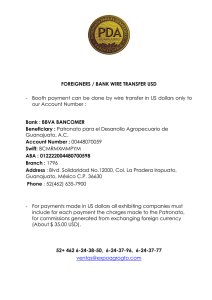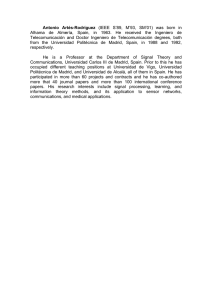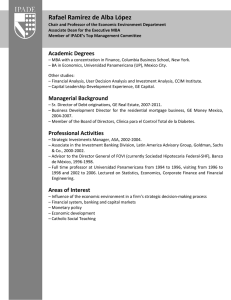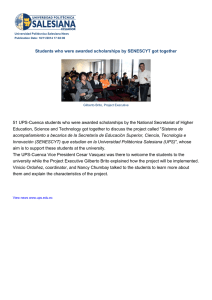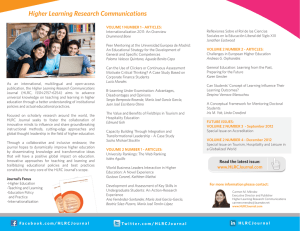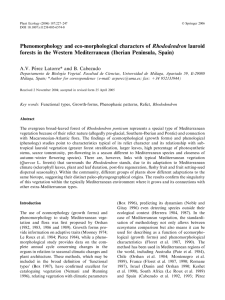Current work at the Robotics group of the Universidad de Guanajuato
Anuncio
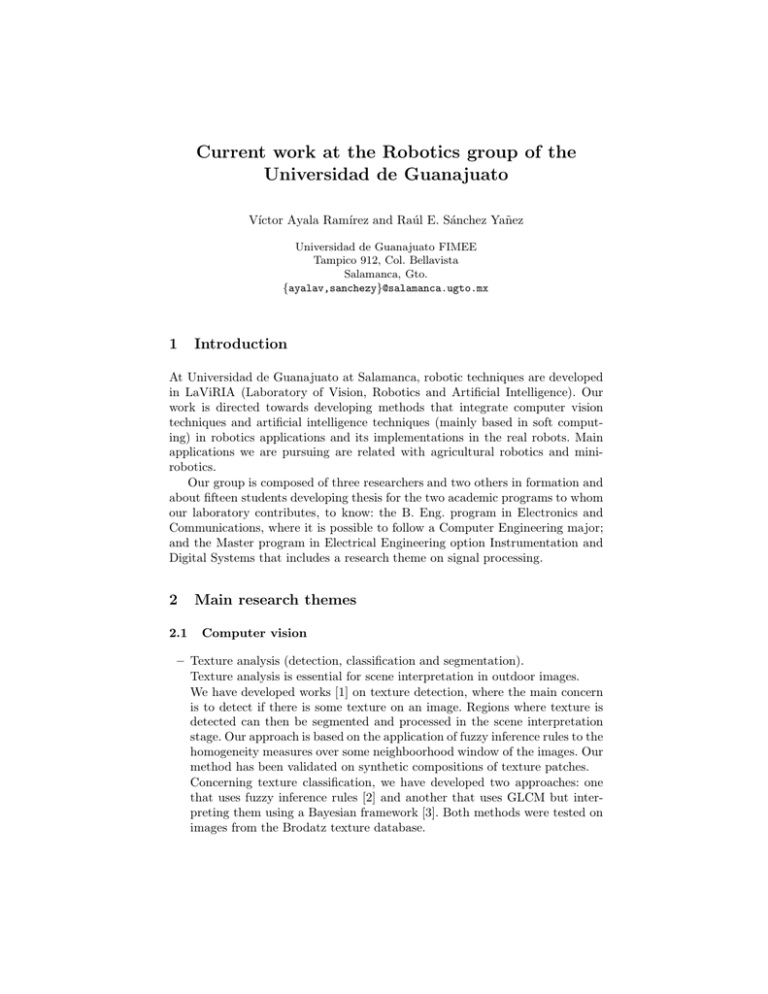
Current work at the Robotics group of the
Universidad de Guanajuato
Vı́ctor Ayala Ramı́rez and Raúl E. Sánchez Yañez
Universidad de Guanajuato FIMEE
Tampico 912, Col. Bellavista
Salamanca, Gto.
{ayalav,sanchezy}@salamanca.ugto.mx
1
Introduction
At Universidad de Guanajuato at Salamanca, robotic techniques are developed
in LaViRIA (Laboratory of Vision, Robotics and Artificial Intelligence). Our
work is directed towards developing methods that integrate computer vision
techniques and artificial intelligence techniques (mainly based in soft computing) in robotics applications and its implementations in the real robots. Main
applications we are pursuing are related with agricultural robotics and minirobotics.
Our group is composed of three researchers and two others in formation and
about fifteen students developing thesis for the two academic programs to whom
our laboratory contributes, to know: the B. Eng. program in Electronics and
Communications, where it is possible to follow a Computer Engineering major;
and the Master program in Electrical Engineering option Instrumentation and
Digital Systems that includes a research theme on signal processing.
2
2.1
Main research themes
Computer vision
– Texture analysis (detection, classification and segmentation).
Texture analysis is essential for scene interpretation in outdoor images.
We have developed works [1] on texture detection, where the main concern
is to detect if there is some texture on an image. Regions where texture is
detected can then be segmented and processed in the scene interpretation
stage. Our approach is based on the application of fuzzy inference rules to the
homogeneity measures over some neighboorhood window of the images. Our
method has been validated on synthetic compositions of texture patches.
Concerning texture classification, we have developed two approaches: one
that uses fuzzy inference rules [2] and another that uses GLCM but interpreting them using a Bayesian framework [3]. Both methods were tested on
images from the Brodatz texture database.
– Object recognition and modeling.
Object recognition is very important in robotic vision applications as in visual servoing or visual tracking tasks. We have developed some methods
using Hausdorff distance to compare object models [4]. Another method [5]
[6] describes regions in an image as color patches in the CIELab color space.
We have also worked in active object recognition using mutual information
[7] where we take advantage of an active sensor to assign a class label for an
object by choosing views that provide optimal information to reduce ambiguity. This procedure is carried out using a mutual information framework
and a Markovian decision process.
– Motion analysis.
Motion analysis is the main component of dynamic tasks in robotic vision.
We work on the motion detection problem [8] where we use a Gaussian
mixture approach to detect motion zones that could be used as target initializations in a target tracking system.
Another work [9] deals with the problem of interaction of several modalities
of tracking methods in order to optimize the visual tracking task of a mobile
robot by following target characteristics and tracking performance over the
temporal evolution of the scenes acquired by a mobile robot.
2.2
Soft computing
– Soft computing libraries.
We have developed object-oriented libraries that implement basic functionalities of soft computing techniques. Fuzzy logic and genetic algorithms [10]
can then be implemented in our sytems easily in order to develop intelligent
systems for robotics applications.
– Model identification using fuzzy systems.
We have also woked on modeling systems from input/output numerical evidence [11]. This has lead us to develop some original methods in fuzzy
clustering and to implement some other classical methods as the Fuzzy-C
means method.
– Genetic algorithm (GA) applications.
Some work is in progress to solve a packaging problem of arbitrary shapes by
using genetic algorithms [12]. This approach is intended to help leather and
textile industries, two very important manufacturing sectors in our region.
We are developing also methods for path planning in robotics that optimize
trajectories for mini-robots by considering uncertainty in tha actual path
execution in the fitness function.
2.3
Robotic applications
– Mini-robotics navigation and mapping
In this subject, we have worked on handling uncertainty in robot position
[13] and how to implement in mini-robots from the Lego Mindstorms series
[14]. We have also used in the past a robot simulator environment developed
–
–
–
–
3
at our laboratory that uses a reactive navigation strategy using fuzzy logic.
In the near future, we will have an all-terrain robot that will serve us to
validate our previous approaches to robot navigation and mapping.
Visual servoing and tracking
A fuzzy approach to visual servoing and its optimization by means of genetic
algorithms has been dealt by Pérez [15]. Color target tracking has been
developed by Montecillo [5]. In its work, target has ben represented by fuzzy
rules that use values in the CIELab color space.
Parametric shape detection using GA
Genetic algorithms were used in a parametric object recognition problem by
Garcia [16]. In this work, circle and ellipses are detected in real-world images.
Some extensions for this method will be applied in industrial metrology
problems.
Modality control of active sensors.
We have worked in the recent years in the modality selection problem for
active sensors (also known as active sensing). Our initial were directed towards path servoing problems [17] [18]. We have recently addressed the active
object recognition problem [19] [7].
Robot architectures
Some works have dealt the sensor/actuator interaction in a robot architecture [20] [21] [22]. Our approach is based on the concept of the intelligent
sensor(actuator) that can be in charge of high level tasks. This enables the
robot to use low bandwidth when communicating with these devices.
Main research projects
– Topological navigation in structured and semi-structured environments.
We are participants of the French-Mexican Laboratory on Informatics (LAFMI).
We are partners with the Laboratory of System Analysis and Architecture in
Toulouse, France to develop techniques for the topological navigation of mobile robots [23]. A first application of these techniques will be demostrated
on a high-cleareance agricultural vehicle designed at FIMEE.
– Fuzzy texture detection for topological navigation.
In this project, we use fuzzy approaches for texture detection, segmentation and classification in natural environments [24]. Main tasks include road
extraction and place recognition.
– Active perception in robotics.
Active perception for outdoor robotics has been the object of a Ecos Nord
project [25]. This project has contributed mainly to fund mobility programs
for researchers in the partner robotics teams during four years.
Some active perception functionalities for mobile robots have been developed
in a CONACYT project [26]. This project has contributed with funding to
buy some vision and computing processing equipment.
4
Conclusions and prospectives
Our group has established a steady flow of human resources trained in our laboratory. We are working to set up a doctoral program and, in parallel, to build
some partnerships with other programs in Mexico and abroad to have doctoral
students that could help us in the development of our laboratory. We are working
towards our consolidation as a research group in robotics applications. We have
already developed some academic research and we have established some partnerships with other laboratories around the world. We need however to develop
knowledge transfert skills in order to impact Mexican industrial environment
and to become more independent with relation to funding issues by obtaining
some contracts with Mexican industries.
References
1. Del Moral Perea, A.: Detección de textura en imgenes usando un modelo difuso
de inferencia. M.E.E. thesis, Universidad de Guanajuato FIMEE (2004)
2. Ramı́rez Chiu, M.A.: Una aproximación difusa a la caracterización de propiedades
de texturas visuales. M.E.E. thesis, Universidad de Guanajuato FIMEE (2004)
3. Ayala-Ramirez, V., Obara-Kepowicz, M., Sánchez-Yáñez, R.E., Jaime-Rivas, R.:
Bayesian texture classification method using a random sampling scheme. In: Proc.
of the 2003 IEEE Int. Conf. on Systems, Man and Cybernetics, Washington, DC,
IEEE Press (2003) 2065–2069
4. Ayala-Ramı́rez, V., Parra, C., Devy, M.: Active tracking based on hausdorff matching. In: Proc. 15th Int. Conf. on Pattern Recognition (ICPR’2000). Volume 4.,
Barcelona, Spain, IEEE Computer Society Press (2000) 706–709
5. Montecillo Puente, F.J.: Sistema de seguimiento de objetos en tiempo real mediante
caracterización difusa del color. B. Eng. thesis, Universidad de Guanajuato (2003)
6. Montecillo-Puente, F.J., Ayala-Ramı́rez, V., Pérez-Garcı́a, A., Sánchez-Yáñez,
R.E.: Fuzzy color tracking for robotic tasks. In: Proc. of the 2003 IEEE Int.
Conf. on Systems, Man and Cybernetics, Washington, DC, IEEE Press (2003)
2769–2773
7. Trujillo-Romero, F., Ayala-Ramı́rez, V., Marı́n-Hernández, A., Devy, M.: Active
object recognition using mutual information. In: Proc. MICAI 2004: Advances in
Artificial Intelligence. Volume 2972 of LNAI., Mexico City, Mexico, Springer Verlag
(2004) 672–678
8. Rincón Casián, J.A.: Detección de movimiento usando mezclas de gaussianas (in
progress). B. Eng. thesis, Universidad de Guanajuato (2004)
9. Marı́n-Hernández, A., Ayala-Ramı́rez, V., Devy, M.: Collaborative tracking for
robotic tasks. In: Proc. of the IEEE/RSJ Int. Conf. on Intelligent Robots and
Systems (IROS’2003). Volume 1., Las Vegas, NE, IEEE Press (2004) 272–277
10. Pérez-Garcı́a, A., Ayala-Ramı́rez, V., Jaime-Rivas, R.: Una librerı́a genérica de
algoritmos genéticos para aplicación enproblemas de optimización. In: Memoria
5to. Congreso Mexicano de Robótica, San Luis Potosı́, Mexico (2003) 141–146
11. Sánchez-Yáñez, R.E., Ayala-Ramı́rez, V., Jaime-Rivas, R.: Fuzzy models for system identification. In: Proc. of the 2003 IEEE Int. Conf. on Systems, Man and
Cybernetics, Washington, DC, IEEE Press (2003) 3330–3335
12. Ponce Pérez, A.: Empaquetamiento de formas arbitrarias usando algoritmos
genéticos (in progress). B. Eng. thesis, Universidad de Guanajuato (2004)
13. López Padilla, R.: Tareas de navegación de un robot móvil bajo incertidumbre. B.
Eng. thesis, Universidad de Guanajuato (2004)
14. Martı́nez Labrada, E.: Estrategias de navegación y construcción de mapas usando
mini-robots (in progress). B. Eng. thesis, Universidad de Guanajuato (2004)
15. Pérez Garcı́a, A.: Servocontrol de una cámara activa usando técnicas geno-difusas.
B. Eng. thesis, Universidad de Guanajuato (2002)
16. Garcı́a Capulı́n, C.H.: Detección de formas paramétricas en imágenes (in progress).
M.e.e. thesis, Universidad de Guanajuato FIMEE (2004)
17. Razo-Razo, M.A., Ayala-Ramı́rez, V.: Exploración coordinada de un ambiente mediante métodos de potencial. In: Memoria CONIELECOMP 2003, Puebla, Mexico,
IEEE Mexico (2003) 201–205
18. Trujillo Romero, F.: Control de modalidades de una cámara activa usando funciones de utilidad. M.E.E. thesis, Universidad de Guanajuato (2002)
19. Pérez-Mendoza, S., Ayala-Ramirez, V., Pérez-Garcı́a, A., Sánchez-Yáñez, R.E.:
Visual servoing for micro-robotic platforms. In: Proc. 14th Int. Conf. on Electronics, Communications and Computers (CONIELECOMP’2004), Veracruz, Mexico,
IEEE Computer Society Press (2004) 18–22
20. Dorado Prieto, A.: Interfaz de comunicación del sistema de instrumentación de un
robot móvil. M.E.E. thesis, Universidad de Guanajuato (2002)
21. Alvarado Martı́nez, T.: Especificación de un actuador inteligente para tareas
robóticas. M.E.E. thesis, Universidad de Guanajuato (2003)
22. Pérez Mendoza, J.S.: Servocontrol visual para plataformas mini-robóticas. B. Eng.
thesis, Universidad de Guanajuato (2003)
23. Ayala Ramı́rez, V., Devy, M.: Concepción de funciones de navegación topológica de
robots móviles en ambientes estructurados y semi-estructurados. Project funded by
LAFMI, Universidad de Guanajuato and Laboratoire d’Analyse et d’Architecture
des Systèmes (2002-2004)
24. Sánchez Yáñez, R.E.: Navegación topológica de robots utilizando análisis difuso
de textura. Project funded by SEP-PROMEP, Universidad de Guanajuato (20032005)
25. Jaime Rivas, R., Devy, M.: Percepción activa para robótica de exterior. Project
funded by ANUIES (México) and Comité ECOS (France) No. M99M01, Universidad de Guanajuato and Laboratoire d’Analyse et d’Architecture des Systèmes
(1999-2003)
26. Ayala Ramı́rez, V.: Concepción de funciones de percepción activa. Project funded
by CONACYT I-39328A, Universidad de Guanajuato (2002)
